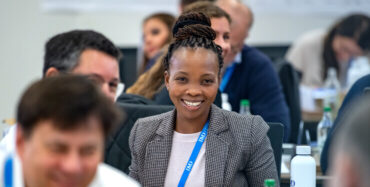In a future that is AI-driven and customer-centric, teamwork is becoming ever more critical for organizations. Yet the effectiveness of teams is being challenged by an increase in the number of teams, the number of meetings, and even the number of people in meetings. This makes it harder to invest in relationships, a crucial factor of high-performing teams.
“A high-performing team is one where members are accountable for each other’s growth,” said Ina Toegel, Professor of Leadership and Organizational Change, during the fifth annual gathering of the SEF.Academy, a day-long event organized by IMD as part of the Swiss Economic Forum’s annual conference.
Dominic Lüthy, Director of Marketing and Communication for the Swiss Economic Forum, noted that teams today face multiple challenges ranging from recruiting and retention to mental health and the clash of different generations.
The Academy’s participants, who ranged from founders and CEOs of startups to executives working in the telecommunications, insurance, and construction industries, explored how they could overcome these challenges and move from a group (where people work individually together) to a team (where you interact in interdependence).
Toegel noted that the English rock band The Beatles weren’t the most technically competent musicians as individuals, but when they came together, they made magic. At the other extreme, leaders sometimes need to encourage their star performers to allow others to excel, if they want to raise the team’s overall performance.
“We can only work together if we have the same vision and create an ecosystem or an environment where the other one can thrive,” reflected Joëlle Frank, Sales and Sustainability Manager at tfy-consult.

Four steps to a high-performing team
Toegel outlined a four-step process for high-performing teams: Create alignment, build trust, coach and provide feedback, and drive learning performance. “Teams need to make sure that they put the steps in the right sequence,” she stressed.
The most neglected step in this process is creating alignment. Before the team gets down to work, it can help to complete a canvas for team alignment covering the team’s purpose, goals, norms, how you want to have fun together, and even the signs people should watch out for when people are getting frustrated.
Equally, it’s important to have open conversations about the roles and dynamics each individual plays within the group. One useful framework is the “Six Thinking Hats,” which assigns roles like the objective White Hat (facts and figures), creative Green Hat, risk-conscious Black Hat, positive Yellow Hat, process-oriented Blue Hat, and emotional Red Hat. Team members should discuss which “hats” they tend to wear and how they can complement each other’s strengths.
Getting these team roles, values, and dynamics out in the open early on drives accountability and avoids counterproductive issues down the road, unlocking the team’s full potential, said Toegel.
Building trust
Another crucial component of a high-performing team is trust. There are two types of trust: competence-based trust, built around task completion, and relationship trust. The latter, being more important, is nurtured by leaders who openly acknowledge mistakes, allow controlled failures for better learning, and take calculated risks to spur innovation.
“Trust is like the crown of a high-performance team. We have to get to know each other even better,” said Claas Vetter, Director Sales and Communications of AMAG Leasing AG. “And in the end, it’s all about communication.”
Toegel shared examples of icebreaking questions, ranging from “What was the first car you drove?” to “If I were an animal, I would most likely be,” that encourage people to open up and lay the groundwork for trust. Importantly, be conscious about the number of people in the team. The smaller the team, the more likely people are to share.

Coaching and feedback
Growth occurs when people feel uncomfortable yet safe – an environment created by leaders who challenge and push their team while making them feel supported. This makes effective feedback, both given and received equally by all team members, a critical component of high-performing teams.
Leaders should consider both the format and content of feedback, said Toegel. New AI tools can help team members strike the right tone, rephrasing an unfiltered email you drafted when feeling irritable into something professional and constructive.
Most importantly, feedback should be timely and not allowed to linger, as delays undermine the process’s value. By mastering this skill, leaders can cultivate an atmosphere of psychological safety – the shared belief that members can speak up and take risks without facing negative consequences – which unlocks their team’s growth.

Driving learning and performance
To ensure that a team learns and grows, leaders can conduct “after-action reviews” or “checkout” sessions that encourage members to systematically rate how each meeting or project went and identify areas for improvement. While there are many different tools, the idea is that you pick the tools that feel most right for your team.
As Toegel concluded: “Leadership is a lot about standing center stage, but a lot of what we’ve discussed today is about placing your teams center stage by having these important conversations.”
IMD’s partner, the SEF, has been convening leaders from business, academia, politics, and the media for the past 26 years. This year’s motto is: “When the going gets tough,” and aims to explore how to lead Switzerland to a successful future. Speakers at the event included Sanna Marin, former president of Finland, Nassim Nicholas Taleb, essayist and risk analyst, and Jeff Rowe, CEO of Syngenta.







